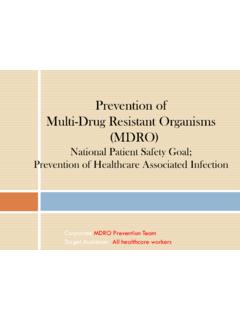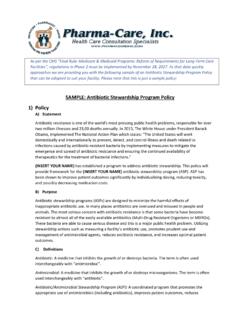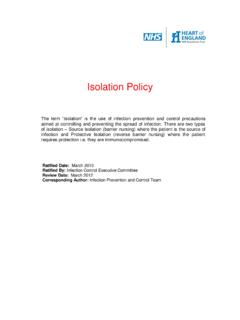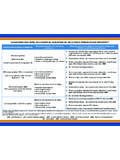Transcription of Infection Control Modules - DBHDD University
1 February 11, 2013 Page 1 Self-Instructional Packet (SIP) Advanced Infection prevention and Control Training Modules February 11, 2013 Page 2 Learning Objectives Module One Introduction to Infection prevention and Control After completing Module One, the learner will be able to: the role of Infection prevention and Control in DBHDD the term pathogen and explain what constitutes an the term healthcare associated Infection (HAI) and explain the difference betweenthese and community associated infections (CAIs). the potential impact on hospitalized individuals and hospital employees whocontract healthcare associated the term colonization and explain the difference between colonization and the term asymptomatic Infection and list two examples of pathogens that can result inasymptomatic infections in some the term carrier and explain the Infection risk that carriers bring to hospitalizedindividuals and hospital five of the typical signs and symptoms of infections and describe the responsibilityhospital employees have to report any of these two multi-drug resistant organisms (MDROs) that are tracked at DBHDD hospitalsand explain why these pathogens pose a significant health risk to hospitalized Name two bloodborne pathogens (BBPs)
2 That are tracked at DBHDD hospitals and explainhow these infections are typically Define the term true exposure and describe what action DBHDD hospital employees musttake when a true exposure Two The Chain of Infection After completing Module Two, the learner will be able to: the Chain of Infection and list at least three of the six essential elements or linksin this at least three examples where the potential for the spread of infections exists atDBHDD hospitals and other healthcare facilities (HCFs). some of the actions and precautions taken by hospital and other healthcare facility(HCF) employees that can help break the chain of Three Standard Precautions After completing Module Three, the learner will be able to: the basic principles of Standard Precautions and when they should be the importance of hand hygiene in the prevention of healthcare associated infections (HAIs) and discuss proper hand hygiene the importance of Personal Protective Equipment (PPE) in the prevention ofhealthcare associated infections (HAIs).
3 At least three examples of Personal Protective Equipment (PPE) used in the term Sharps and can list at least two examples of sharps that can beencountered in DBHDD 11, 2013 Page 3 why the handling and disposal of sharps are so how sharps can be safely handled and explain the proper disposal method what constitutes contaminated waste and the proper disposal the importance of adult immunizations in the prevention of healthcare associatedinfections (HAIs).10. List at least two examples of adult immunizations that are available to individuals andemployees in DBHDD Four Transmission-Based Precautions After completing Module Four, the learner will be able to: the term Transmission-Based Precautions and explain the general indication forthese groups of the term Contact Precautions and explain when and how they are the term Droplet Precautions and explain when and how they are the term Airborne Precautions and explain when and how they are at least one pathogen that was presented in this module for which Contact Precautionsare at least one pathogen that was presented in this module for which Droplet Precautionsare at least one pathogen that was presented in this module for which AirbornePrecautions are Five Selected Pathogens After completing Module Five, the learner will be able to.
4 The term Bloodborne Pathogens (BBPs) and name at least two examples of bloodborne pathogens presented in this the Infection Control precautions indicated for bloodborne pathogens (BBPs). the term Contact Transmitted Pathogens and name at least two contact transmitted pathogens presented in this the Infection Control precautions indicated for contact transmitted the term Droplet Transmitted Pathogens and name at least two droplet transmittedpathogens presented in this the Infection Control precautions indicated for droplet transmitted the term Airborne Pathogens and name at least two airborne pathogens presented in this the Infection Control precautions indicated for airborne transmitted the difference between tuberculosis (TB) Infection and tuberculosis (TB) 11, 2013 Page 4 MODULE ONE Introduction to Infection prevention and Control 1) Introduction A) Infection prevention and Control (IPC)
5 Is the specialized discipline comprised of highly trained professionals that are concerned with preventing the spread of Infection in hospitals and other healthcare facilities (HCFs). These professionals working in DBHDD hospitals are involved in a variety of activities, including but not limited to: 1) Developing and implementing an overall Infection prevention and Control Plan for each hospital along with Exposure Control Plans for bloodborne pathogens (BBPs), multi-drug resistant organisms (MDROs), and Tuberculosis (TB). 2) Conducting Infection surveillance, performing outbreak investigations, and managing infectious outbreaks. 3) Conducting Infection prevention and Control rounds, monitoring hospital employee hand hygiene practices, and assisting with Infection and prevention Control (IPC) training. 4) Reviewing sterilization, disinfection, and aseptic techniques performed by hospital employees.
6 5) Assisting with immunization programs for individuals and hospital employees. 2) Terminology A) Microorganisms are tiny living entities that are only visible under a microscope. The Infection or disease causing varieties are the pathogenic microorganisms and are often referred to as pathogens. Although pathogens may belong to any one of the five classes of microorganisms, (Bacteria, Viruses, Protozoa, Fungi, and Rickettsia), surveillance has shown that most infections that are identified in DBHDD hospitals are caused by bacteria and viruses. Perhaps the most significant of these for individuals and hospital employees are the multi-drug resistant organisms (MDROs) and the bloodborne pathogens (BBPs). B) Infection is the invasion of pathogens into blood and other body tissues where they flourish and proliferate. Infection usually results in cellular death and tissue damage that can be localized or widespread.
7 For example, infections such as skin boils usually cause only localized tissue damage; whereas infections such as tuberculosis (TB) usually cause widespread tissue damage and can affect entire body systems and functions. The infections that affect entire body systems and functions are usually referred to as infectious disease; however to simplify the terminology in these Modules , the term Infection will be used when referring to both localized infections and more widespread disease processes. C) Healthcare Associated infections (HAIs) are infections that are contracted in hospitals and other healthcare facilities (HCFs). For example, an Infection that is contracted prior to admission, but is not clinically evident until days after admission, would not be considered a healthcare associated Infection (HAI). However, an February 11, 2013 Page 5 Infection that is contracted prior to discharge, but is not clinically evident until days after discharge, would be considered a healthcare associated Infection (HAI).
8 The impact of healthcare associated infections (HAIs) can be very serious, for example; 1) A healthcare associated Infection (HAI) that is contracted by a hospitalized individual can result in extended hospitalization, additional medical procedures and healthcare costs, a reduced quality of life, and in some instances death. 2) A healthcare associated Infection (HAI) that is contracted by a hospital employee can result in missed work, lost wages, medical expenses, hospitalization, a reduced quality of life, and in some instances death. For these reasons, DBHDD hospitals are committed to the Control and prevention of healthcare associated infections (HAIs). For Additional Information regarding Healthcare Associated infections , go to; D) Community Associated infections (CAIs) are infections that are contracted in community settings rather than hospital or other healthcare facilities (HCFs).
9 E) Asymptomatic infections are infections that exhibit little or no visible signs or symptoms; although medical testing will usually reveal the presence of Infection . At first, the typical signs and symptoms of Infection may be present; however, over time they can diminish and almost completely disappear. For example, hepatitis B (HBV) and hepatitis C (HCV) can become asymptomatic infections in some individuals. F) Colonization is the presence of pathogens residing superficially at one or more body sites without invasion, cell death, or tissue damage. Like those with asymptomatic infections , people with colonized pathogens do not show any signs or symptoms. While colonization is not technically an Infection , colonized pathogens do present a serious Infection risk. This is true because colonized pathogens can readily spread, and given the opportunity, can develop into full blown infections at any time.
10 Pathogens such as Methicillin Resistant Staphylococcus Aureus (MRSA), Vancomycin Resistant Enterococcus (VRE), and Clostridium difficile (C. diff) are notorious for colonizing the elderly residing in nursing homes and other long-term care facilities (LTCFs). G) Carrier is the collective term used to describe; 1) persons with asymptomatic infections , and 2) persons who are colonized with pathogens. These people present a special challenge in hospitals and other healthcare facilities (HCFs) because they can spread infections to others without anyone knowing that they carry pathogens. For this reason, it is important for doctors and nurses working in DBHDD hospitals to identify these individuals as soon as possible. February 11, 2013 Page 6 3) Signs and Symptoms of Infection A) People with infections usually present with signs and symptoms that reflect the type of pathogen, its virulence, and the infected individual s overall medical status.









